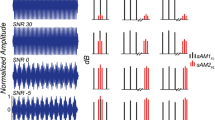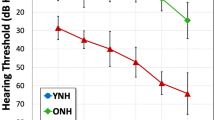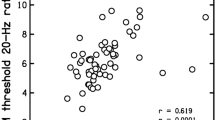Abstract
Natural sounds can be characterized by their fluctuations in amplitude and frequency. Ageing may affect sensitivity to some forms of fluctuations more than others. The present study used individual differences across a wide age range (20–79 years) to test the hypothesis that slow-rate, low-carrier frequency modulation (FM) is coded by phase-locked auditory-nerve responses to temporal fine structure (TFS), whereas fast-rate FM is coded via rate-place (tonotopic) cues, based on amplitude modulation (AM) of the temporal envelope after cochlear filtering. Using a low (500 Hz) carrier frequency, diotic FM and AM detection thresholds were measured at slow (1 Hz) and fast (20 Hz) rates in 85 listeners. Frequency selectivity and TFS coding were assessed using forward masking patterns and interaural phase disparity tasks (slow dichotic FM), respectively. Comparable interaural level disparity tasks (slow and fast dichotic AM and fast dichotic FM) were measured to control for effects of binaural processing not specifically related to TFS coding. Thresholds in FM and AM tasks were correlated, even across tasks thought to use separate peripheral codes. Age was correlated with slow and fast FM thresholds in both diotic and dichotic conditions. The relationship between age and AM thresholds was generally not significant. Once accounting for AM sensitivity, only diotic slow-rate FM thresholds remained significantly correlated with age. Overall, results indicate stronger effects of age on FM than AM. However, because of similar effects for both slow and fast FM when not accounting for AM sensitivity, the effects cannot be unambiguously ascribed to TFS coding.









Similar content being viewed by others
References
Demany L, Semal C (1989) Detection thresholds for sinusoidal frequency modulation. J Acoust Soc Am 85:1295–1301. doi:10.1121/1.397460
Füllgrabe C (2013) Age-dependent changes in temporal-fine-structure processing in the absence of peripheral hearing loss. Am J Audiol 22:313. doi:10.1044/1059-0889(2013/12-0070)
Füllgrabe C, Moore BCJ, Stone MA (2015) Age-group differences in speech identification despite matched audiometrically normal hearing: contributions from auditory temporal processing and cognition. Front Aging Neurosci 7:1–25. doi:10.3389/fnagi.2014.00347
Gallun FJ, McMillan GP, Molis MR et al (2014) Relating age and hearing loss to monaural, bilateral, and binaural temporal sensitivity. Front Neurosci 8:1–14. doi:10.3389/fnins.2014.00172
Grose JH, Mamo SK (2010) Processing of temporal fine structure as a function of age. Ear Hear 31:755–760. doi:10.1097/AUD.0b013e3181e627e7
Grose JH, Mamo SK (2012) Frequency modulation detection as a measure of temporal processing: age-related monaural and binaural effects. Hear Res 294:49–54. doi:10.1016/j.heares.2012.09.007
Hartmann WM, Hnath GM (1982) Detection of mixed modulation. Acustica 50:297–312
He N, Mills JH, Dubno JR (2007) Frequency modulation detection: effects of age, psychophysical method, and modulation waveform. J Acoust Soc Am 122:467–477. doi:10.1121/1.2741208
He N, Mills JH, Ahlstrom JB, Dubno JR (2008) Age-related differences in the temporal modulation transfer function with pure-tone carriers. J Acoust Soc Am 124:3841–3849. doi:10.1121/1.2998779
Hopkins K, Moore BCJ (2011) The effects of age and cochlear hearing loss on temporal fine structure sensitivity, frequency selectivity, and speech reception in noise. J Acoust Soc Am 130:334–349. doi:10.1121/1.3585848
King A, Hopkins K, Plack CJ (2014) The effects of age and hearing loss on interaural phase difference discrimination. J Acoust Soc Am 135:342–351. doi:10.1121/1.4838995
Lacher-Fougère S, Demany L (1998) Modulation detection by normal and hearing-impaired listeners. Audiology 37:109–121
Levitt H (1971) Transformed up-down methods in psychoacoustics. J Acoust Soc Am 49:467–477. doi:10.1121/1.1912375
Loeb GE (2005) Are cochlear implant patients suffering from perceptual dissonance? Ear Hear 26:435–450
Loeb GE, White MW, Merzenich MM (1983) Spatial cross-correlation. Biol Cybern 47:149–163
Maiwald D (1967a) Die Berechnung von Modulationsschwellen mit Hilfe eines Funktionsschemas. Acustica 18:193–207
Maiwald D (1967b) Ein Funktionsschema des Gehörs zur Beschreibung der Erkennbarkeit kleiner Frequenz-und Amplitudenänderungen. Acustica 18:81–92
Micheyl C, Schrater PR, Oxenham AJ (2013) Auditory frequency and intensity discrimination explained using a cortical population rate code. PLoS Comput Biol 9:e1003336. doi:10.1371/journal.pcbi.1003336
Moore BCJ, Ernst SMA (2012) Frequency difference limens at high frequencies: evidence for a transition from a temporal to a place code. J Acoust Soc Am 132:1542–1547. doi:10.1121/1.4739444
Moore BCJ, Sek A (1992) Detection of combined frequency and amplitude modulation. J Acoust Soc Am 92:3119–3131. doi:10.1121/1.404208
Moore BCJ, Sek A (1994) Effects of carrier frequency and background noise on the detection of mixed modulation. J Acoust Soc Am 96:741–751
Moore BCJ, Sek A (1995) Effects of carrier frequency, modulation rate, and modulation waveform on the detection of modulation and the discrimination of modulation type (amplitude modulation versus frequency modulation). J Acoust Soc Am 97:2468–2478. doi:10.1121/1.411967
Moore BCJ, Sek A (1996) Detection of frequency modulation at low modulation rates: evidence for a mechanism based on phase locking. J Acoust Soc Am 100:2320–2331. doi:10.1121/1.417941
Moore BCJ, Skrodzka E (2002) Detection of frequency modulation by hearing-impaired listeners: effects of carrier frequency, modulation rate, and added amplitude modulation. J Acoust Soc Am 111:327–335. doi:10.1121/1.1424871
Moore BCJ, Glasberg BR, Stoev M et al (2012a) The influence of age and high-frequency hearing loss on sensitivity to temporal fine structure at low frequencies (L). J Acoust Soc Am 131:1003. doi:10.1121/1.3672808
Moore BCJ, Vickers DA, Mehta A (2012b) The effects of age on temporal fine structure sensitivity in monaural and binaural conditions. Int J Audiol 51:715–721. doi:10.3109/14992027.2012.690079
Neff DL (1986) Confusion effects with sinusoidal and narrow-band noise forward maskers. J Acoust Soc Am 79:1519–1529. doi:10.1121/1.393678
Otsuka S, Furukawa S, Yamagishi S et al (2016) Relation between cochlear mechanics and performance of temporal fine structure-based tasks. J Assoc Res Otolaryngol 17:541–557. doi:10.1007/s10162-016-0581-9
Oxenham AJ (2016) Predicting the perceptual consequences of hidden hearing loss. Trends Hear 20:1–6. doi:10.1177/2331216516686768
Oxenham AJ, Micheyl C, Keebler MV (2009) Can temporal fine structure represent the fundamental frequency of unresolved harmonics? J Acoust Soc Am 125:2189–2199. doi:10.1121/1.3089220
Oxenham AJ, Micheyl C, Keebler MV et al (2011) Pitch perception beyond the traditional existence region of pitch. Proc Natl Acad Sci U S A 108:7629–7634. doi:10.1073/pnas.1015291108
Paraouty N, Lorenzi C (2017) Using individual differences to assess modulation-processing mechanisms and age effects. Hear Res 344:38–49. doi:10.1016/j.heares.2016.10.024
Paraouty N, Ewert SD, Wallaert N, Lorenzi C (2016) Interactions between amplitude modulation and frequency modulation processing: effects of age and hearing loss. J Acoust Soc Am 140:121–131. doi:10.1121/1.4955078
Ross B, Fujioka T, Tremblay KL, Picton TW (2007) Aging in binaural hearing begins in mid-life: evidence from cortical auditory-evoked responses to changes in interaural phase. J Neurosci 27:11172–11178. doi:10.1523/JNEUROSCI.1813-07.2007
Ruggles D, Bharadwaj H, Shinn-Cunningham BG (2012) Why middle-aged listeners have trouble hearing in everyday settings. Curr Biol 22:1417–1422. doi:10.1016/j.cub.2012.05.025
Saberi K, Hafter ER (1995) A common neural code for frequency- and amplitude-modulated sounds. Nature 374:537–539. doi:10.1038/374537a0
Schoof T, Rosen S (2014) The role of auditory and cognitive factors in understanding speech in noise by normal-hearing older listeners. Front Aging Neurosci 6:1–14. doi:10.3389/fnagi.2014.00307
Sergeyenko Y, Lall K, Liberman MC, Kujawa SG (2013) Age-related cochlear synaptopathy: an early-onset contributor to auditory functional decline. J Neurosci 33:13686–13694. doi:10.1523/JNEUROSCI.1783-13.2013
Shamma SA (1985) Speech processing in the auditory system II: lateral inhibition and the central processing of speech evoked activity in the auditory nerve. J Acoust Soc Am 78:1622–1632. doi:10.1121/1.392800
Shamma S, Klein D (2000) The case of the missing pitch templates: how harmonic templates emerge in the early auditory system. J Acoust Soc Am 107:2631–2644. doi:10.1121/1.428649
Sheft S, Yost WA (1990) Temporal integration in amplitude modulation detection. J Acoust Soc Am 88:796–805. doi:10.1121/1.399729
Steiger JH (1980) Tests for comparing elements of a correlation matrix. Psychol Bull 87:245–251
Strelcyk O, Dau T (2009) Relations between frequency selectivity, temporal fine-structure processing, and speech reception in impaired hearing. J Acoust Soc Am 125:3328–3345. doi:10.1121/1.3097469
Viemeister NF (1979) Temporal modulation transfer functions based upon modulation thresholds. J Acoust Soc Am 66:1364–1380. doi:10.1121/1.383531
Wallaert N, Moore BCJ, Lorenzi C (2016) Comparing the effects of age on amplitude modulation and frequency modulation detection. J Acoust Soc Am 139:3088–3096. doi:10.1121/1.4953019
Whiteford KL, Oxenham AJ (2015) Using individual differences to test the role of temporal and place cues in coding frequency modulation. J Acoust Soc Am 138:3093–3104. doi:10.1121/1.4935018
Yost WA (1974) Discriminations of interaural phase differences. J Acoust Soc Am 55:1299–1303. doi:10.1121/1.1914701
Zwicker E (1956) Die elementaren Grundlagen zur Bestimmung der Informationskapazität des Gehörs. Acustica 6:365–381
Zwicker E (1970) Masking and psychological excitation as consequences of the ear’s frequency analysis. In: Plomp R, Smoorenburg GF (eds) Frequency analysis and periodicity detection in hearing. Sijthoff, Leiden, pp 376–394
Acknowledgments
This work was supported by a grant from the National Institutes of Health (R01 DC005216).
Author information
Authors and Affiliations
Corresponding author
Ethics declarations
Conflict of Interest
The authors declare that they have no conflict of interest.
Rights and permissions
About this article
Cite this article
Whiteford, K.L., Kreft, H.A. & Oxenham, A.J. Assessing the Role of Place and Timing Cues in Coding Frequency and Amplitude Modulation as a Function of Age. JARO 18, 619–633 (2017). https://doi.org/10.1007/s10162-017-0624-x
Received:
Accepted:
Published:
Issue Date:
DOI: https://doi.org/10.1007/s10162-017-0624-x




